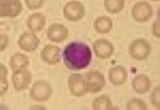
Wright's stain
Encyclopedia
Wright's stain is a histologic stain that facilitates the differentiation of blood cell
types. It is used primarily to stain peripheral blood smears and bone marrow
aspirates
which are examined under a light microscope. In cytogenetics
it is used to stain chromosomes to facilitate diagnosis of syndromes and diseases.
It is named for James Homer Wright
, who devised the stain, a modification of
the Romanowsky stain
, in 1902. Because it distinguishes easily between blood cells, it became widely used for performing differential white blood cell
counts, which are routinely ordered when infections are suspected.
There are related stains known as the buffered Wright stain, the Wright-Giemsa stain, and the buffered Wright-Giemsa stain, and specific instructions depend on the solutions being used, which may include Eosin Y
, Azure B, and Methylene Blue
(some commercial preparations combine solutions to simplify staining). The May-Grünwald stain, which produces a more intense coloration, also takes a longer time to perform.
White blood cells stained with Wright's stain:
|->




Blood cell
A blood cell, also called a hematocyte, is a cell normally found in blood. In mammals, these fall into three general categories:* red blood cells — Erythrocytes* white blood cells — Leukocytes* platelets — Thrombocytes...
types. It is used primarily to stain peripheral blood smears and bone marrow
Bone marrow
Bone marrow is the flexible tissue found in the interior of bones. In humans, bone marrow in large bones produces new blood cells. On average, bone marrow constitutes 4% of the total body mass of humans; in adults weighing 65 kg , bone marrow accounts for approximately 2.6 kg...
aspirates
Needle aspiration biopsy
Needle aspiration biopsy , may refer to fine needle aspiration cytology , fine needle aspiration biopsy and fine needle aspiration , is a diagnostic procedure sometimes used to investigate superficial lumps or masses...
which are examined under a light microscope. In cytogenetics
Cytogenetics
Cytogenetics is a branch of genetics that is concerned with the study of the structure and function of the cell, especially the chromosomes. It includes routine analysis of G-Banded chromosomes, other cytogenetic banding techniques, as well as molecular cytogenetics such as fluorescent in situ...
it is used to stain chromosomes to facilitate diagnosis of syndromes and diseases.
It is named for James Homer Wright
James Homer Wright
Dr. James Homer Wright was an early and influential American pathologist, who from 1896 to 1926 was chief of pathology at Massachusetts General Hospital. Wright was born in Pittsburgh, Pennsylvania....
, who devised the stain, a modification of
the Romanowsky stain
Romanowsky stain
Romanowsky staining is a prototypical staining technique that was the forerunner of several distinct but similar methods, including Giemsa, Jenner, Wright, Field, and Leishman stains, which are used to differentiate cells in pathologic specimens....
, in 1902. Because it distinguishes easily between blood cells, it became widely used for performing differential white blood cell
White blood cell
White blood cells, or leukocytes , are cells of the immune system involved in defending the body against both infectious disease and foreign materials. Five different and diverse types of leukocytes exist, but they are all produced and derived from a multipotent cell in the bone marrow known as a...
counts, which are routinely ordered when infections are suspected.
There are related stains known as the buffered Wright stain, the Wright-Giemsa stain, and the buffered Wright-Giemsa stain, and specific instructions depend on the solutions being used, which may include Eosin Y
Eosin Y
Eosin Y is a form of eosin....
, Azure B, and Methylene Blue
Methylene blue
Methylene blue is a heterocyclic aromatic chemical compound with the molecular formula C16H18N3SCl. It has many uses in a range of different fields, such as biology and chemistry. At room temperature it appears as a solid, odorless, dark green powder, that yields a blue solution when dissolved in...
(some commercial preparations combine solutions to simplify staining). The May-Grünwald stain, which produces a more intense coloration, also takes a longer time to perform.
White blood cells stained with Wright's stain:





